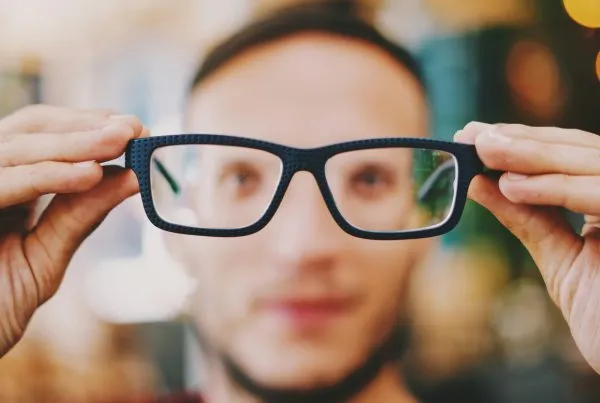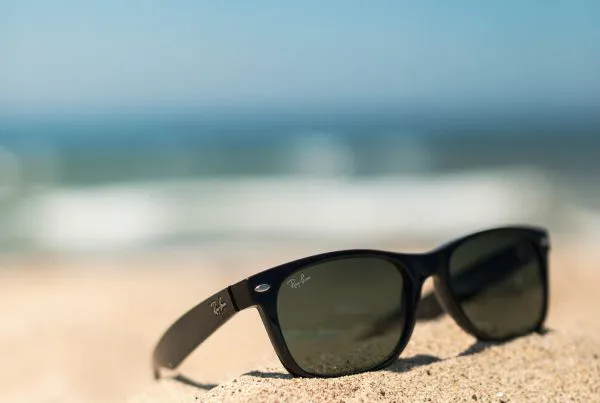Imagine a world where you no longer need to switch between pairs of glasses just to focus on a menu or spot a familiar face across the room. For millions, bifocal and varifocal glasses provide this convenience—but how do you decide which is right for you?
The answer lies in the unique way each lens addresses your vision needs. They are specially designed to hold two different prescriptions, which means you can see objects far away and up close through one spectacle. These glasses are great for people suffering from multiple vision disorders such as hypermetropia, myopia, presbyopia, and astigmatism.
Bifocals, with their unmistakable split-lens design, handle near and distance vision separately but leave a gap for intermediate clarity. Varifocals, on the other hand, offer a modern solution with smooth progression between distance, intermediate, and near vision—all in one lens.
This guide will break down the technical differences, benefits, and use cases of each, helping you decide which type of lens suits your unique needs.
What are Bifocal Glasses?

Bifocal has a visible distinct line across the lens to divide both prescriptions. The top part is designed to help with distance vision, while the bottom part helps with near vision. They are usually prescribed to people with presbyopia. It’s an age-related condition that weakens the eye muscles and makes it harder to focus on close objects.
Benjamin Franklin, the founding father of America, is credited for the invention of bifocal glasses. He was tired of switching between eyeglasses for near and far vision, so he combined the two lenses, inventing Bifocals.
When wearing bifocal lenses, you have to move your eyes above or below the visible line to focus on objects. It can take some time to get used to, but it gives a clear vision for near and far distances.
Benefits of Bifocal Glasses
Bifocal glasses offer a practical solution for individuals needing vision correction for both near and far distances. With distinct sections for close-up and distance viewing, they provide clear vision without needing multiple pairs of glasses:
- Dual Vision: This type of corrective eyeglass meets two different corrective needs, distance and near- one can be switched on both easily
- Cost-advantage: Compared with other types of multifocals, bifocals can be cost-effective for anyone seeking budget-friendliness.
- Clear Separation for Easy Adjustment: The clear demarcation between the near and far sections of the lens ensures easy adjustment as the patient gets accustomed to wearing new glasses.
- Suitable for Every Activity: It can be used in everyday activities such as reading, driving, or TV viewing; bifocals make it unnecessary to possess a set of multiple eyeglasses.
- No Multiple Pair Required: Bifocals enable people to perform a wide range of activities without switching between glasses, thus improving everyday convenience.
Who Should Choose Biofocal Glasses?
They are especially beneficial for people who mainly engage in activities like reading or driving, where a clear distinction between close-up and distance vision is essential. If you are looking for a easy and affordable solution for dual vision needs, bifocal glasses provide the right balance of functionality and simplicity.
What are Varifocal Glasses?

Varifocal glasses, also known as Progressive Lenses, offer a seamless transition between multiple viewing zones without the visible line. It provides a unified vision solution for near, intermediate, and distance corrections.
The upper segment is tailored for distance vision, and the middle section caters to intermediate distances, such as reading menus or computer work. The lower section assists in near-vision tasks like sewing. Varifocal glasses feel more natural as they are designed according to your body’s natural position.
The adaptation time for acclimating to different zones within the varifocal lenses and using them effectively for various activities can take a couple of weeks.
Benefits of Varifocal Glasses
Varifocal glasses are an innovative and convenient option for those who have to correct vision at multiple distances. The following are some of the main advantages of varifocal lenses:
- Smooth Transition: Varifocals provide a smooth, unbroken transition between near, intermediate, and distance vision, doing away with the requirement for several pairs of glasses.
- Comfort: These lenses are suitable for individuals who constantly change between tasks like reading, computer use, or driving, as they offer convenience without changing glasses.
- Aesthetic Appeal: Unlike bifocals, varifocals have no visible lines, which makes them more attractive and modern.
- Natural Vision: Varifocals enable more natural vision since they mimic the natural focusing process of the eye, allowing clarity at every distance without visible zones.
- Better peripheral vision: Continuity in the lens shape means the wearer will have better peripheral vision compared with the bifocal. Its progressive lens design provides a broader, clearer view.
Who Should Choose Varifocal Glasses?
Varifocals are ideal for users who prefer an all-in-one solution for distance, intermediate, and near vision with no lines showing. It offers convenience while enabling a more natural and comfortable way of viewing across all distances.
Key Differences Between Bifocal and Varifocal Lenses
| Feature | Bifocal Glasses | Varifocal Glasses |
| Lens Design | Has two distinct sections: one for distance, one for near vision. | Smooth transition across multiple focal points (near, intermediate, and far). |
| Visible Lines | The visible line divides the two zones, making it noticeable. | No visible lines, providing a seamless and modern look. |
| Adaptation Period | Shorter adjustment period. Users get used to the two zones quickly. | Takes longer to adjust, as the brain adapts to the gradual lens changes. |
| Field of View | Limited field of view due to the division between zones. | Full field of view, allowing for clear vision at all distances. |
| Aesthetic Appeal | It can look outdated due to the visible line across the lens. | Aesthetically pleasing and modern, with no lines or segments. |
| Comfort | Comfortable for people who need basic near and far vision, but not ideal for intermediate focus. | Provides comfort for a range of activities, but may take time to adjust to the smooth transition. |
| Price | Generally more affordable than varifocal lenses. | Takes longer to adjust as the brain adapts to the gradual lens changes. |
| Vision Clarity | Clear vision for near and distance, but intermediate vision may be blurry. | Clear vision at all distances (near, intermediate, and far). |
Bifocals vs Varifocals – Which One to Choose?
Varifocals are more aesthetically pleasing due to their single-vision appearance. Yes, it is a little challenging to get used to them, but when you get accustomed to them, varifocals will provide a more comfortable viewing experience and peripheral vision.
Bifocals have been around for much longer and are more affordable. So, if you are looking for functionality with two distinct prescriptions, they are a better and more budget-friendly option.
FAQs
Can I get bifocal lenses with a different prescription for each eye?
Yes, bifocal lenses can be customized using different prescriptions for each eye.
Do varifocal glasses cause dizziness or discomfort?
Some users may feel dizziness or discomfort initially, but it usually resolves after an adjustment period.
Can I use varifocal lenses for reading and computer work?
Yes, varifocal lenses are perfect for reading, computer work, and other jobs requiring multiple focal distances.






